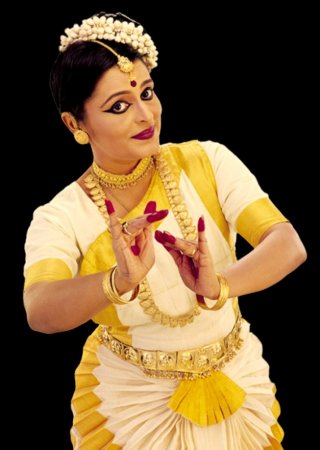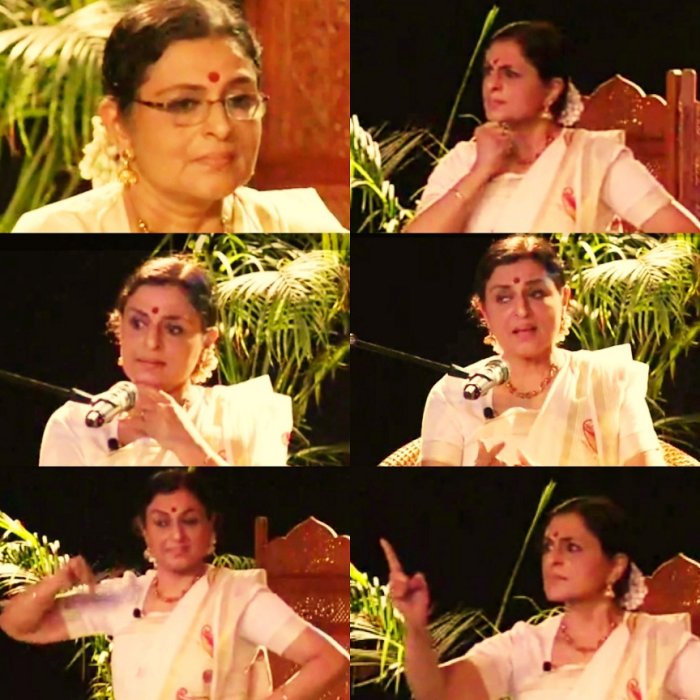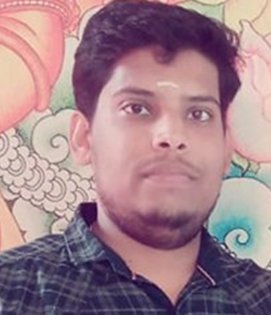
|   |

|   |
Deepti Omchery Bhalla -The quest for enriching Mohiniattam - Hari Shankar e-mail: hshankar252@gmail.com July 15, 2020 Amidst this pandemic scenario, when the art and artistes' space is hit over past several months and virtual dance festivals and performances are going on even though not satisfying the audience with the contentment of an on-stage performance, Central Sangeet Natak Akademi, New Delhi has taken a more innovative way of engaging the art connoisseurs with new initiatives and programs telecast from its treasured archival collections. Recently, they organized an interactive webinar session titled ANTARANG, where senior artistes from different facets of dance and music go on a live interview with a provision for the viewers to have their queries answered. This session with illustrious Mohiniattam exponent Prof. Deepti Omchery Bhalla, stands out for her multifaceted virtuosities. References to Mohiniattam can be found in texts like Vyavaharamala written by Mazhamangalam Narayanan Namboothiri in 1709. Since then, it had many phases of ebb and flow. The dance form of Kerala was revitalized by Travancore King Maharaja Swati Tirunal. His untimely demise led to the depreciation of this dance. After long years of degradation and being untended, this dance form got a new life by the efforts of restructuring and reviving by Mahakavi Vallathol Narayana Menon, who founded Kerala Kalamandalam with Manakkulam Mukunda Raja in 1930. Among the then earliest students of Mohiniattam, Vallathol entrusted Kalamandalam Kalyanikutty Amma for his vision to secure Mohiniattam, an exclusive place in the art world. Kalyanikutty Amma's untiring efforts to analyse Mohiniattam, her contributions, her reformations, earned her the title of "Mother of Mohiniattam." After the renaissance by Kalyanikutty Amma, her disciples enriched the repertoire with many new compositions and choreographies. Among them, Dr. Deepti Omchery Bhalla's name and her contributions remains quite foremost and significant. Over more than past four decades, Deepti has researched along with the support of her mother Dr. Leela Omchery, veteran musicologist and Sopanam music scholar. She has choreographed and experimented with many new items without compromising on the traditional aesthetics of the dance form. Her quest has always been in creating new possibilities in Mohiniattam, especially in the nritta aspect and in the musicality of the art form by unearthing rare and indigenous compositions and talas of Kerala. Her proficiency in both Carnatic music and Sopana Sangeetham along with expertise in Hindustani music, has helped her evolve as well as to contribute much to the repertoire. Here, Dr. Deepti Bhalla, who currently serves as Dean, Faculty of Music and Fine Arts, University of Delhi, shares her journey with her audience with Helen Acharya as the moderator.  Deepti Omchery Bhalla Her tryst with Kerala percussion veterans includes Kallekulangara Achuthankutty Marar, who taught her kooru in edakka and rare Kerala talas, gurus like Kalamandalam Shankaran Warrier, who has systemized the playing of maddalam and published an authentic reference book on maddalam, which is perhaps, the only comprehensive guide to the playing and understanding of this instrument. Thrikamburam Krishnankutty Marar, the tyaani expert, taught her many melodies, tyaanis, rare talas and its tough systematics. Her interactions with Prof. Kadamanitta Vasudevan (Padayani), Kurichi Kumaran (Arjuna Nrittam expert), Aymanam Krishna Kaimal, Dr. Appukuttan Nair, gave her a clear understanding of even the subtle nuances of the art forms. She recalls how Kavalam Narayana Panicker used to make her listen to his recordings of folk songs of Kerala and to analyse the rhythmic patterns used in Koodiyattam, Theyyam, Mudiyettu, Nangiarkoothu, and made her understand and absorb the underlined essence of these art forms. Her initial training in Kathakali at International Centre for Kathakali, New Delhi under veteran gurus like late Punnathur Madhava Panikkar, late Guru Gopinath, late Sadanam Nanda Kumar, Nelliyodu Vasudevan Nampoothiri and Sadanam Balakrishnan, has helped her to adapt to these tricky talas and to integrate them into Mohiniattam. Through oral tradition, her mother had the opportunity to learn certain compositions and also many folk songs that have a typical flavor of the region without any refinement, as we see today, from her grandmother. Hailing from Kanyakumari district, the then Travancore capital (now in Tamil Nadu), Suchindram, Parassala circle and being near to the thousand year old Thiruvattar Adikeshava Perumal Temple, it was easy for both Leela Omchery and Deepti to get acquainted with the ritualistic practices prevalent there then, like Kottipadi Seva (a service to God, where edakka and vocal music are conjointly sung to propitiate the deity) and many other performances. She even had access to churuls (palm leaf manuscripts) by which she could understand certain aspects of the temple music. Deepti's father Prof. Omchery N N Pillai, renowned playwright and theatre personality, hails from Vaikom and Deepti recalls her childhood days there, of the hours long conversation between the veteran artistes from Vaikom Kshetra Kala Peetham, Kottayam, and her mother about various compositions, singing technique, and rhythmic patterns. Later, they compiled these rare compositions, even unknown to the people of that region, along with the research work done later and published a book, Abhinaya Sangeetham in 1981 and also recorded for Sangeet Natak Akademi, Indira Gandhi National Centre for Arts and Invis Multimedia. She has unearthed several Nritta Prabhandams, Shabdachalis, Daru Varnam, Thalamalika Padams, etc. She is one of the first Mohiniattam dancers, who used 'Vathilthura pattukal' by Kuttykunji Thankachi, daughter of the royal composer Irayimman Thampi, in Mohiniattam. It is a genre of compositions similar to javalis, lurid poetry, which is quite popular in other southern states. Unlike the khandita nayika of javali, where she turns away from the nayaka for having deceived her, the nayika here always regrets her outburst and seeks forgiveness and invites the lord to come to her. The words used are rustic and colloquial, not as refined as in padam. She enacted "Avale thava ramani", one such composition. She presented small glimpses of how she incorporated certain vaytharis (syllables) of Mudakku thalam (Kshetra anushtana vadya tala), in edakka, maddalam, and Arjuna Nrittam in three of her distinct choreographies. Amba Gauri: A much acclaimed choreography of Dr. Deepti is this popular Stava varnam by Irayimman Thampi in Arabhi ragam and triputa talam which is in praise of the presiding goddess of Thiruvarattukavu Temple near Attingal, Thiruvananthapuram. She presented three very complex rhythmic patterns that she learnt by her interaction with Maddala Shankara Warrier. It was noteworthy how Deepti skillfully incorporated such strong rhythmic vaytharis without losing the soft nature of the dance form. Samvaada Padam: Composed by Maharaja Swati Thirunal in ragam Poorva Kamodari, the melodic pattern used here is slightly different from what Carnatic musicians have notated it, as it was learnt by her mother through oral tradition. This padam was very interesting as it had a very skeptical conversation between the nayika and her sakhi, who deceived the nayika by spending amorous time with her beloved lord. The nayika slyly questions the sakhi to know the truth. The cleverer sakhi responds so sagaciously. On asking why her face is sweating (Kaminimani! sakhi! tavaka mukhaminnu, kamamsvinnamayatende vada!). Sakhi accounts it to the scorching heat of the bright sun (tamarasabaandhava kiranamettu, tantamayi nitaantam mama vadanam). Oh the one, with eyes of a young deer! Why are both your eyes reddish? (Tarunamrganayane! tava lochanayugalam, arunataram aayathayende vada?). It is due to the anger raised in me because of hearing harsh words from him about you, (Taruni! tava dayitavachananuditakopena, paramarunamayi ennarika thozhi). Why is the vermilion on your forehead erased? (Kunkuma pankamazhivaanendu karanam?). My upper garment (saree pallu) might have rubbed over it, (Pankajaakshi! Uttariya karshanathal) replies sakhi. Nayika ultimately says, 'Whatever you spoke is all a lie; now listen to my words, I know that you must have united with the very charming Shri Padmanabha.' (Manini nee chonnathellam asathyam! Iniyum mama vacham shrnukimapi. Sarasanam Sree Padmanabhanodu nee saha, ramichu vannathum njan arinjathathre..!!) Adi Keshava Nrittaprabhandam: This is one such composition that she obtained from churuls. The much noted choreography of Dr. Deepti, is in praise of Adikeshava, the presiding deity of Thiruvattar Adikeshava Perumal Temple, near Kanyakumari district, set in Tukka ragam. The stanzas go like chandaas (poetic metre, which can be set to music). The vaytharis (syllables) used in this involves rendering it in different paced rhythmic composites, which is a peculiarity of Kerala temple music tradition of invoking and revoking of powers of the deities, starting with a slow tempo, gaining a crescendo and coming to the original initial pace, which she has very aptly incorporated into this item.  In addition to these, Dr. Deepti responded to some of the selected questions by the participants. Are mudakku tala, triteya tala part of marga talas? Actually, there are only five marga talas. But in 108 talas, there are some talas where you will find references of those talas in Kerala talas also, like Rajavidyadhara tala, in which I have choreographed Dubdhubhi Natyam. But like Mudakku, Thakuddu talas, there are some other talas which were a part of marga talas that were once prevalent in southern temples. How do you incorporate the percussion vaytharis into such a lyrical dance form? This is a big challenge that I had been facing. Many of the talas, they are not small pieces; they go as a long extended piece, starts from one end and ends at the other end only. There are no aruthis or thirumanams to know this is the finale, like usually we repeat thrice to make the viewers understand that this is a finale of this section. But here it's not like that. These vaytharis, I very sensitively had to include into the rhythmic component of the dance form. I feel, even though maddalam is ideally suited for nritta aspects, mridangam's tonal quality has a soft tone which many times enhances the expression and also the soft footwork, so I have to incorporate these vaytharis into mridangam, that is how I am using now. Yes, it is a difficult task and we have to think very carefully when we are using these vaytharis in our choreography. Can you share something about Nritta Prabhandams? Prabhandams are pre-structured, pre-set compositions. These prabhandas have been given certain sections, certain divisions based on the tala, the datus and the angas. Those angas and datus, at least a few of them, which once existed, are found even today in the pre-set compositions. Probably, they were written at a time when there was no clarity of whether it is a krithi, javali, or a thillana, which came much later. So, perhaps these were composed by anonymous authors who just felt that this is a prabhandam. Anything that is composed is prabhandam. We have found during our research certain compositions in which it is only written, a prabhanda. We have Geeta Prabhandas, Vadya Prabhandas and Nritta Prabhandas in earlier Sanskrit texts. Nritta Prabhandas are those which are suited for dance. So, whoever has written, he /she must have taken that terminology that existed at that time. What are the items you use in Mohiniattam? I am thankful that you asked this question. Many a times, some dancers had mistakenly thought that whatever I am presenting is a completely different repertoire and that I want to do away with the traditional repertoire of padams, padavarnams, cholkettu, which is the part of traditional Mohiniattam repertoire. The reason I did padavarnam of Irayimman Thampi today was only to establish the fact that I have not tried to meddle with any of the traditional forms. I have choreographed Padams, Padavarnams, which I have learnt from Kalamandalam Kalyanikutty Amma and also from her daughter; I have learnt two / three Jatiswarams and have done that also. What I wanted to do was that, in the Padavarnam, instead of making it more into a padam format, I wanted to enhance the nritta aspect. In Kerala, when Mohiniattam padavarnams were choreographed, if you are a regular viewer of Mohiniattam, you might have observed that it is more abhinaya oriented; there is not much nritta in that. As I said earlier my outlook is to only see how I could contribute to the music and rhythmic aspect to enhance its nritta and I have not changed the repertoire at all. The Shivachalis, Shabdachalis, Nritta Prabhandams, Ardhanareeshwara, all these are part of the Kerala region itself. It's not that I have created it. Even the Samvada Padam, Vathilyurapattu are part of Kerala music but it never came out and now many dancers are choreographing so many items which are not part of the tradition. But tradition means you have to let it flow, move ahead, forward. Whatever connects that particular change to the region and does not compromise or confronts the aesthetics of that form, I think we can incorporate. From where did you get these churuls and the details for these compositions? (Laughing) Well, it is difficult to answer from where we got these. But I would say, actually a lot of these compositions have been learnt by my mother through oral traditions. You might have heard of Ammaveedu, the houses connected to royal palaces when Kanyakumari used to be the capital of Travancore. Because she hails from there and her house was close by, she being very passionate to learn new songs and compositions, would visit these houses where old women would be singing these folk songs and many other compositions which my mother learnt and noted down. When we finally approached and discussed with the royal families, they also finally accepted that. They also perhaps found that there was some evidence that this Vathithurapattu by Kuttykunju Thankachi, certain compositions like a Thalamalika Padam of Irayimman Thampi, were not known till we brought it out through our research and also the Samavada Padam that I did today of Swati Thirunal; I don't think many people were aware of this particular composition before we published it; now, of course, it is coming in print. Dr. Deepti Omchery still continues her deep research to understand more about the analysis of Mohiniattam by her Guru Kalamandalam Kalyanikutty Amma through understanding the concepts, her techniques, her choreographies, and with the constant interaction with Kala Vijayan, daughter of Kalyanikutty Amma. Dr. Rita Swami Choudhary, Secretary, Sangeet Natak Akademi thanked Dr. Deepti Omchery Bhalla for taking time for this Webinar in these very challenging times.  Delhi based A.M. Hari Shankar currently working as an Editor in a leading publishing company by profession, is a percussionist and an art enthusiast by passion. |